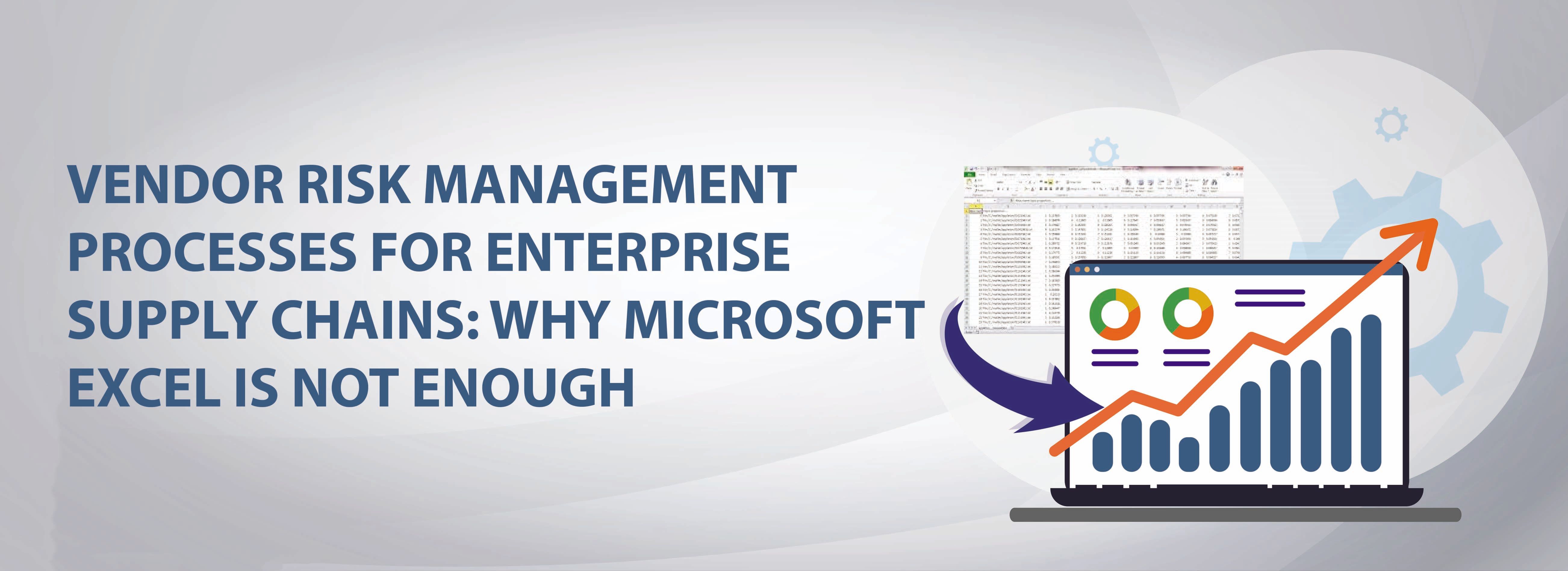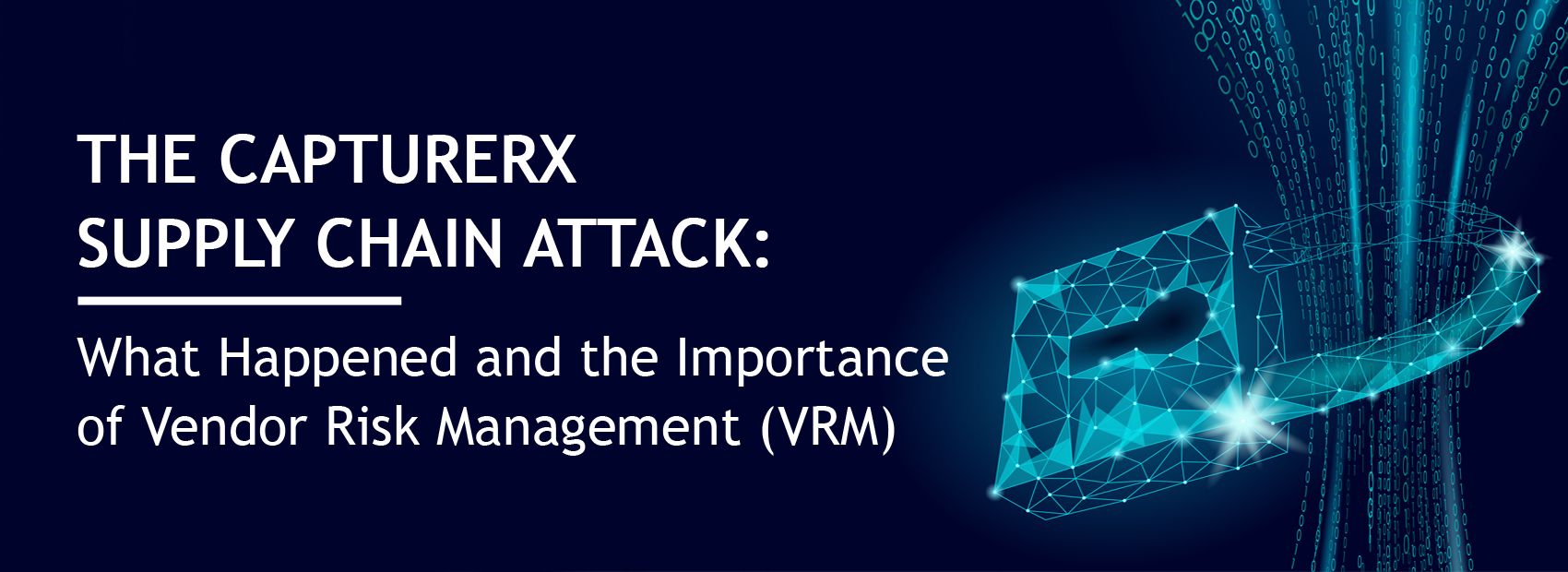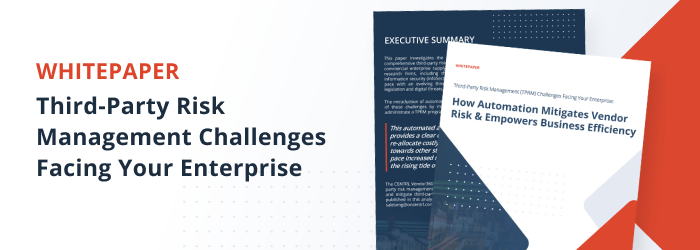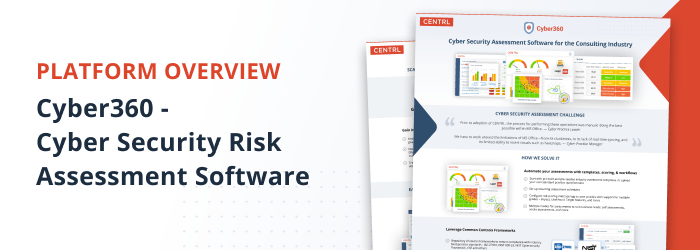Vendor Risk Management Processes for Enterprise Supply Chains: Why Microsoft Excel is Not Enough

Risk management is a critical component of running a successful business. And with the excessive reliance of enterprises on third-party vendors and supply chains spanning borders and continents, cyber and Vendor Risk Management (VRM) has become all the more important.
Designing an enterprise Third-Party Risk Management (TPRM) process to identify and mitigate risks involves extensive work. The goal is to develop a robust Third-Party Risk Management strategy to safeguard the enterprise against third-party risks, becoming more sophisticated over time.
Many companies rely on Microsoft Excel to manage their Vendor Risk Management processes. However, while Excel is popular in the corporate world, it is not just the right tool for TPRM. In this post, we’ll tell you why. We’ll also discuss the most reliable VRM approach of supply chain risk mitigation. But before we go there, let’s take a quick look at why VRM matters for enterprise supply chains.
Why VRM Matters for Enterprise Supply Chains
Increased competition has caused most enterprises to rely on vendors for smooth, profitable, and competitive operations. From software service providers and raw materials to transportation and Information Technology (IT), the modern supply chain has become a complex stakeholders’ network, essential to competitive advantage.
With more interconnectivity and digitization come an array of risks. Supply chain cyber risks are among the main risks that businesses face today.
Enterprise Supply Chain Risk Management (SCRM) has become crucial because of the rising supply chain attacks and their adverse impacts. Supply chain attacks whereby threat actors exploit vulnerabilities and flaws in vendors’ products, services, or cybersecurity defenses rose 78 percent from 2017 to 2018. Moreover, ⅔ of all data breaches happen due to vendor vulnerability.
Your IT vendors are significant because vulnerabilities in their products and services can expose your enterprise to data breach risks. The international IT outsourcing market was worth $333.7 billion in 2019, and it is headed to hit a mark of nearly $400 billion by 2025. This trend hints at more potential supply chain attacks.
VRM reduces enterprise supply chain risks to a great extent. Using a robust VRM program, you can keep an eye on risk trends and threat actors’ behaviors and minimize the impact of supply chain disruptions, maintaining business continuity. In addition, the comprehensive set of policies and guidelines helps you choose your vendors with due diligence, close security loopholes, mitigate risks, and manage your overall supply chain risks.
A good Vendor Risk Management process will help prevent potential blows to your enterprise’s reputation, save you from regulatory and legal troubles, help you make quick and informed decisions, and prevent costly data breaches.
While VRM is invaluable to businesses that use supply chains, many companies use Microsoft Excel to manage their VRM processes. Unfortunately, using Excel spreadsheets to address a critical cybersecurity component for your business is not practical at all. Read on to learn why!
Top Vendor Risks Facing Supply Chains
The first stage in any supplier risk management program is identifying particular threats. So let’s take a closer look at a few of the types of risks related to the global supply chains:
Financial Risks
These risks might vary from an unexpected or unfavorable shift in currency rates to the bankruptcy of a supplier.
Budget overruns, discovering the limits, constructive adjustments, and missed milestones necessitating additional financing are all instances of financial risks. In addition, unexpected cost overruns, which may be connected to other risk factors such as changes in the scope of work necessary to finish the activity effectively, are also potential risks in this category.
Scope of Schedule Risks
These are vital threats that threaten the timeframe, but as previously said, they can also have financial repercussions. They are primarily the result of inadequate project definition or a poorly drafted Statement Of Work (SOW).
Schedule modifications are frequently caused by natural disasters or by non-compliance concerns caused by the supplier. In addition, scope risk can arise due to necessary revisions when the initial SOW becomes unrealistic or due to market-driven technical advancements.
Legal and Regulatory Compliance Risks
Legal and contractual risks are sometimes associated with disagreements or differing interpretations of contractual duties or failure to achieve the requirements outlined in the terms and conditions. In addition, the use or misuse of intellectual property can also be seen as a legal risk, mainly when a patent violation is possible.
Some regulations can hold a company liable for the non-compliance of its suppliers. Companies must ensure that their suppliers have adequate cybersecurity and data protection levels.
Environmental risks
It is vital to examine the threat to the ecosystem posed by your supplier or contractor during the sourcing process. Environmental risk refers to an organization’s negative impact on water, air, and soil due to discharges, emissions, and other types of waste.
Drawbacks of Using Microsoft Excel for Enterprise VRM
Sure, Microsoft Excel is a popular tool to compute, analyze, and present data. It is easy to use and has comprehensive visualization layers, pivot tables, formulae, and more. So it makes sense to use this tool for financial purposes even today! But do you think that it is suitable for managing your VRM processes?
The fact: Notwithstanding its benefits and popularity in the corporate world, MS Excel is not designed for Vendor Risk Management because VRM is an excessively data-driven and intelligence-driven process. Excel is a legacy tool, and the more you rely on it, the weaker your supply chain security.
Higher Error Rates
A study conducted at the University of Hawaii in 2008 found that almost 90 percent of spreadsheets contain errors. The errors were found in a few percent of all cells. That means the larger the spreadsheet document becomes, the more mistakes.
While in non-crucial operations, these errors would be accepted as a justified trade-off (given the many benefits of Excel), in critical areas such as supply chain cybersecurity, the consequences of even a tiny error can be disastrous for your business.
Lack of Capacity
Vendor risk management requires compiling, processing, and analyzing vast volumes of data. MS Excel lacks the necessary intelligence and capacity to process such a massive data cache. The supply chain risk environment is also sophisticated and changes rapidly; spreadsheets cannot accommodate these complexities.
Single-User
MS Excel is designed as a single-user software. While version control can be applied, when many different users have the same privilege or duty, the risk of errors rises significantly. And there’s a risk that the essential functions will be mismanaged because each user will use them according to their preferences. This can lead to disorder and confusion.
Lack of Advanced Features
MS Excel is a calculation software, not an assessment tool. VRM requires quick analysis, assessments, projections, risk monitoring, what-if scenarios, simulations, planning, and more. These functions are beyond the capacity of spreadsheets.
Lack of Intelligence
Spreadsheets don’t come with built-in intelligence features. As such, they don’t give insights into risks and threats - an essential element of Supply Chain Risk Management.
Scalability Limitation
Enterprises grow over time, and so do their VRM needs and requirements. Unfortunately, excel offers no support to adapt to your growing business requirements, except for duplicating a document.
The Next Step
So, what are your options beyond Microsoft Excel to run your VRM processes more effectively?
For most enterprises, the answer is dedicated, advanced, and more powerful VRM software that not only overcomes the shortages in Excel but also gives you complete control over your supply chain management, from risk identification and assessment to supplier onboarding and monitoring.
The next-generation Vendor Risk Management solutions are designed to collect real-time data from across the supply chain ecosystem and store it on a centralized server. That improves the due diligence process. In addition, you can rest assured that everyone will have access to the same database, and unlike spreadsheets, the chances of errors are zero with VRM software.
A reliable SCRM software will come with high-capacity cloud storage that you can scale as your business and requirements grow. These solutions also come with in-built intelligence for quick risk assessments, insights, monitoring, planning, modeling, and more. On top of that, the software is easy to use and generates presentable reports, besides providing a complete view of user activities through audit trails.
So, now is the time to ditch those Excel sheets and choose a reliable VRM software like Vendor360.
Here’s a comment from one of our clients that we heard during a call:
“I’ve an upcoming meeting with a big client’s CISO. As CISO’s do, he will dig into how we do assessments. And, if he finds out we are still using excel for them, it will derail the whole meeting. We need an efficient and effective cloud solution, and we found that in CENTRL.”
Get Vendor360 by CENTRL for Your Enterprise?
Our third-party and Vendor Risk Management software Vendor360 incorporates all the benefits of good VRM software, as discussed above. On top of that, it automates the assessment, audit, and monitoring processes, providing you with complete control over the VRM process.
This software uses the centralized vendor directory to make vendor selection and onboarding a breeze. Arm your business and supply chain members with Vendor360 for quick response to risks and threats. Get rich and actionable insights and analytics with the vendor risk trends.
Want more reason to choose our software? Learn more about Vendor360 or take the software on a test drive with a Live Demo.


